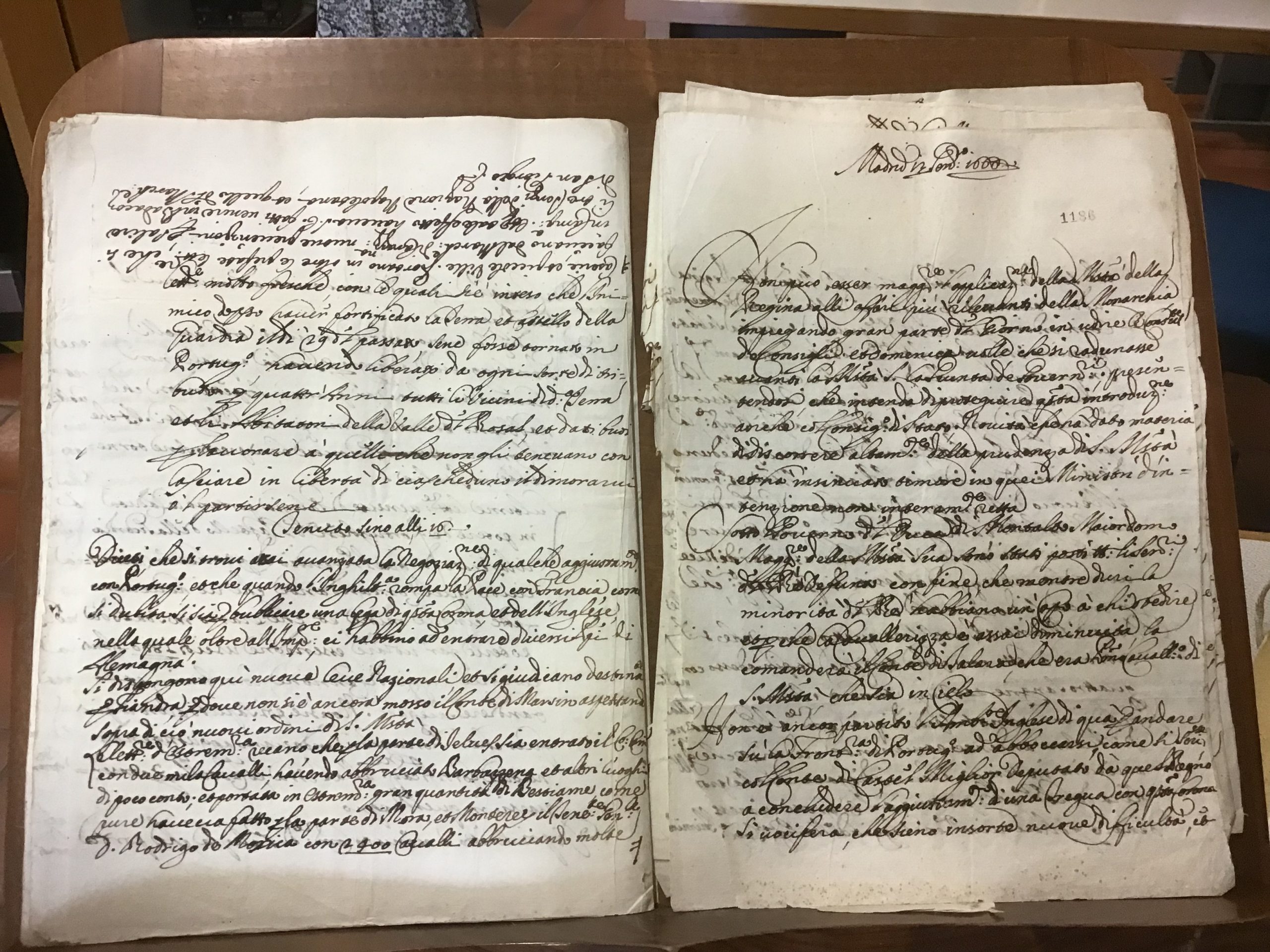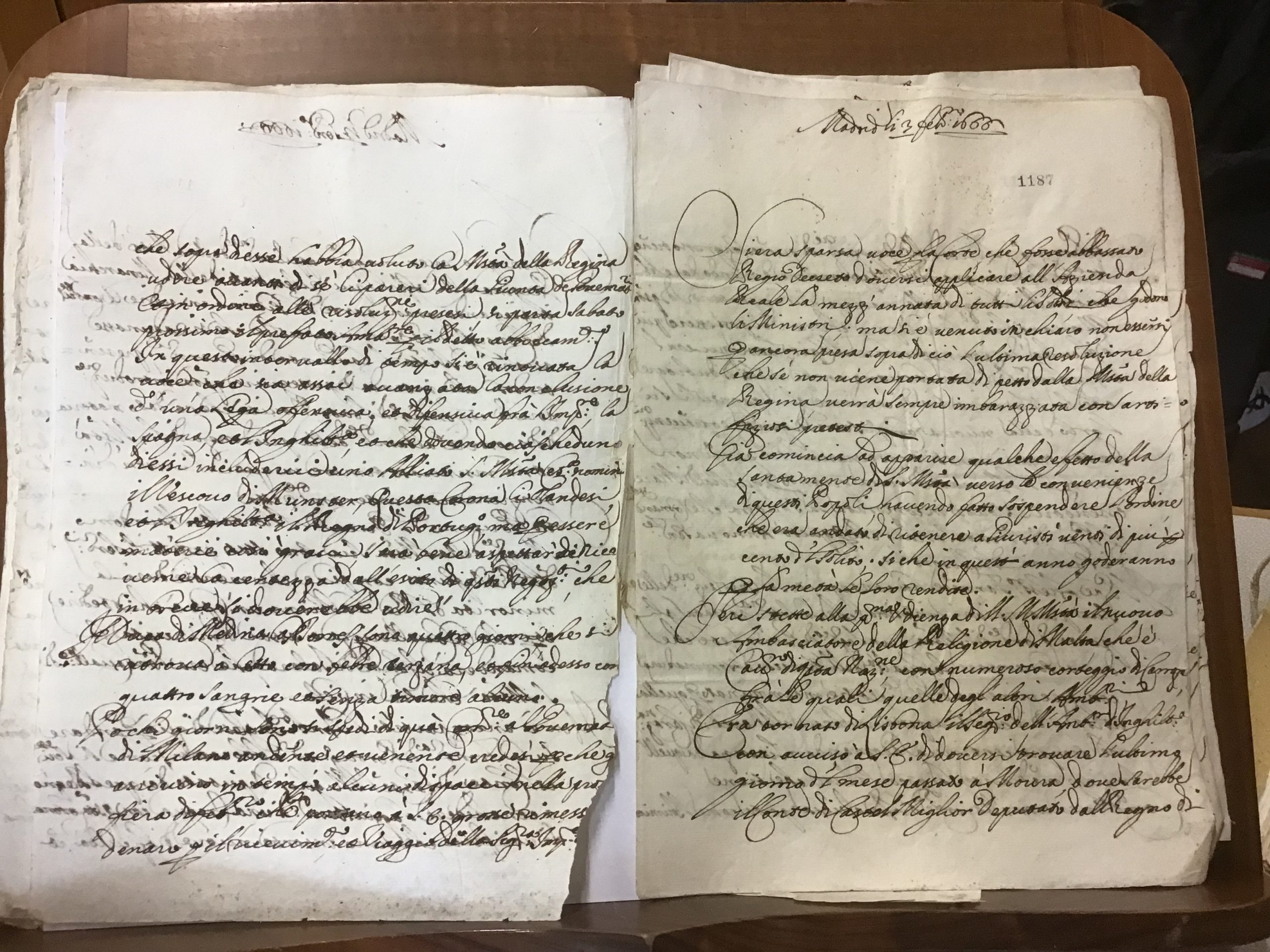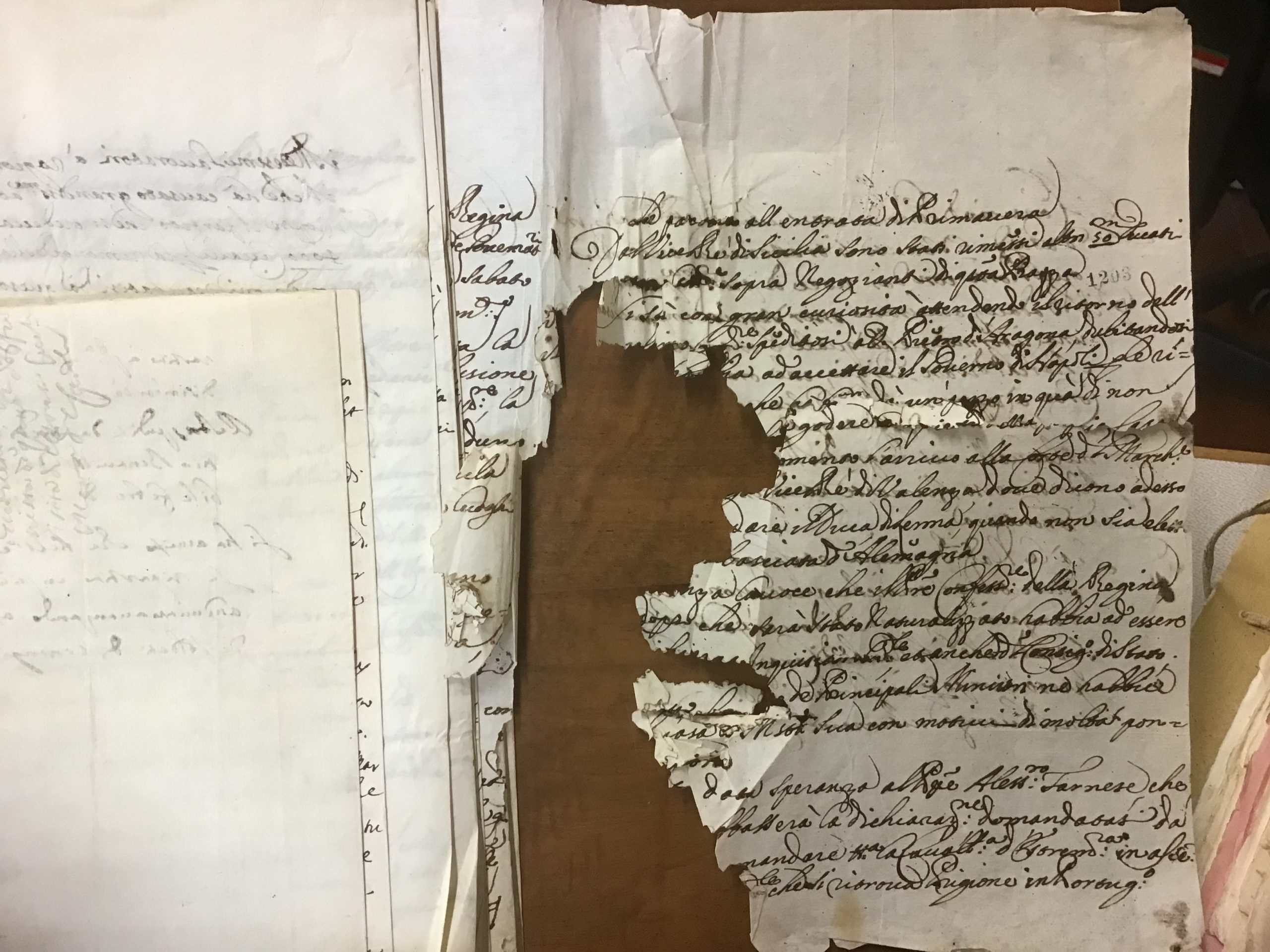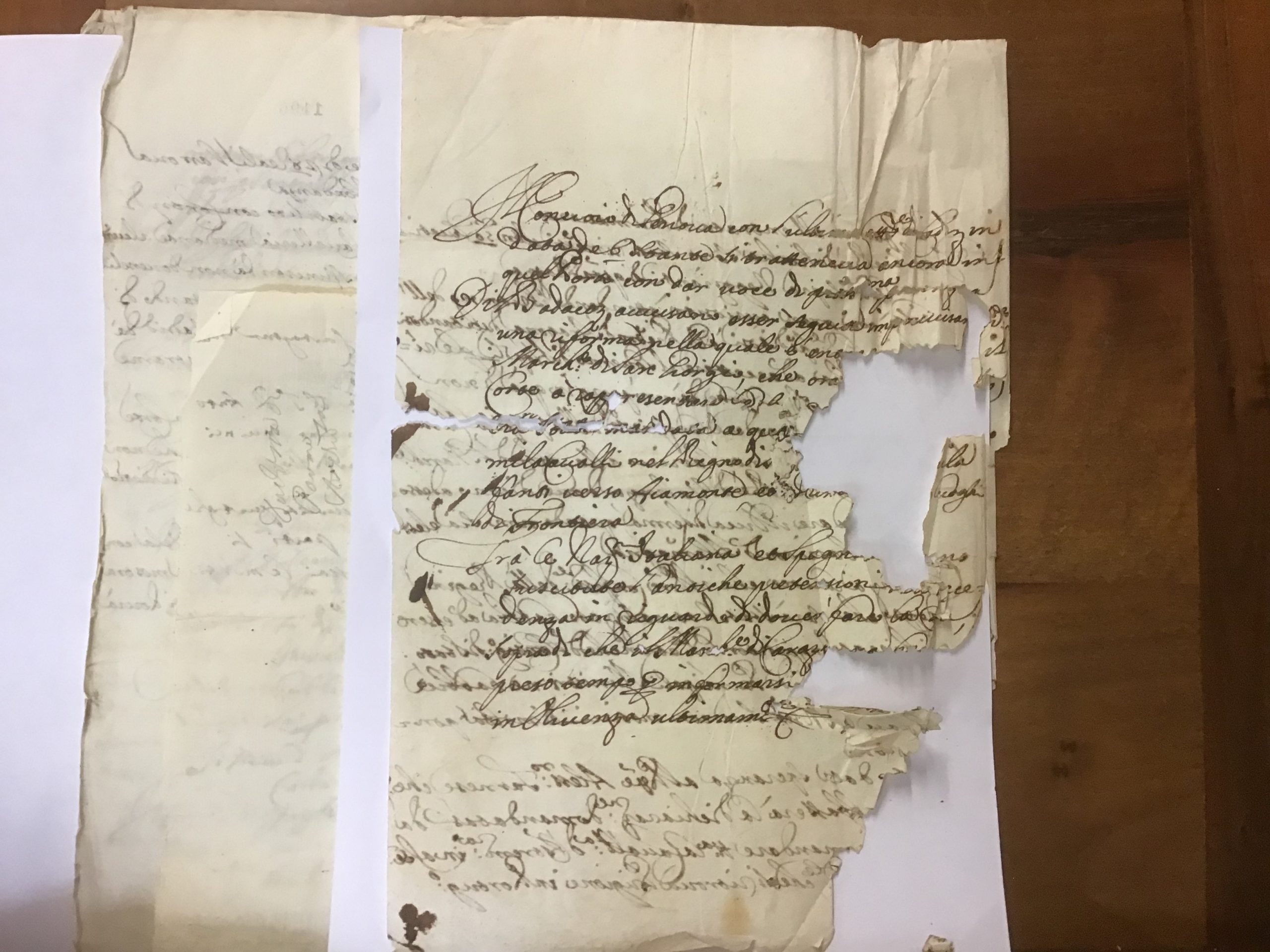Historians spend a lot of time trying to piece things together. Like Sherlock Holmes, in a famous analogy suggested by Carlo Ginzburg, they view assorted vaguely related clues and from these they derive possible hypotheses about how to put together a plausible story about the past.
But piecing together the past sometimes takes place in a very literal sense. Consider this example. Keep in mind that handwritten newsletters were conserved for a long time, but not always in ways that make them easy to consult. For reasons having to do more with the convenience of the archivist than that of the user, sometimes an avviso was used as a folder within which to file assorted other avvisi.
We are looking at vol. 5078 in the Archivio di Stato in Florence, and in the image below, at folio 1186 recto (on the right) we find a handwritten newsletter dated Madrid, 13 September 1666 consisting of a bifolio (folded sheet), now being used as a sheaf to hold together the whole pile of newsletters we see poking out from underneath.
1185 verso - 1186 recto

Let’s look for a second at one of these assorted newsletters inside the folio. Below on the left is the back of 1186r above (i.e. 1186 verso), which breaks off abruptly with a missing piece from the page. On the right (1187r) is another newsletter, dated Madrid 3 February 1666. .
1186 verso - 1187 recto

Next, not shown, we would find, on fol. 1189r, another newsletter, followed by yet another, dated Madrid 24 February, and another on folio 1191r dated the 10th of March.
Having finished going through all the sheets in this bunch, we arrive at the rest of the bifolio we started with. The sheet, as shown on the left below, numbered 1203r, is in very bad shape.
fol. 1203r

But before we try to figure out what is going on here, let us give credit to the Medici Archive Project Mia database, which permits the reconstruction of any one of these newsletters, by virtually reassembling the images to make them “readable” again. Here is the entry for our bifolio:

Returning to the newsletter that began on fol. 1203r, we can just about make out this text, with lacunae indicated mostly by ellipses (rough translation on the right):
[...] Si à così gran curiosità attendendo il ritorno dell' [mutilated] spenditori al duca Pietro d'Aragona, dubitandosi [mutilated] ad accettare il governo di Napoli per le ri[mutilated] che fra [...] un passo in quà di non [...] godere quiete della propria casa [...] momento l'arrivo alla Corte del Marchese [...] Vice Rè di Valenza a dove dicono adesso [...]dare il Duca di Lerma, quando non sia eletto [...] ambasciata d'Alemagna.
[...] a la voce che il Padre Confessore della Regina [...] dopo che sarà stato naturalizzato habbia ad essere [...] Inquisitori[...] et anche del Consiglio di Stato. [...] dei principali Ministri ne habbia [...] casa [...] Maestà Sua con motivi di molta pon[...]
[...] data speranza al Principe Alessandro Farnese che [...]abbasserà la dichiarazione domandatasi da [...] mandare [...] d'Estremadura in asie[...] che si ritrova prigione in Portugallo.
[...] There is much curiosity as we await the return of the [mutilated] bursars to Duke Pietro d'Aragona, whereas it is thought that [mutilated] to accept the government of Naples considering the re[mutilated] that between [...] a step in here of not [. ...] enjoy the peace of his own house [...] moment the arrival at Court of the Marquis [...] Viceroy of Valencia such that they now say [...]give the Duke of Lerma, if he is not elected [...] ambassadorship of Germany..
[...] to the rumor that the Father Confessor of the Queen [...] after having been naturalized has to be [...] Inquisitori[...] and also of the Council of State. [...] of the principal Ministers has [...] the house [...] His Majesty with reasons of much [...]
[...] given hope to Prince Alessandro Farnese that [...] he will lower the declaration requested by [...] to send [...] from Extremadura in [...] who is now imprisoned in Portugal.
Turning over the folio to view fol. 1203v and isolating this by a sheet of paper to avoid optical confusion, we find:

Partial transcription and (on the left) relevant translation:
Il Corriero di Genova con l'ultime lettere di Cadiz in data de 6 stante si tratteneva ancora in quel Porto con dar voce di [...]
Di Badaioz accusano esser seguiti [...] una riforma nella quale è [...] Marchese di San Giorgio, che ora [...] Corte a rappresentare [...]
The courier of Genova with the last letters from Cadiz dated on the 6th of this month was still in that Port giving voice to [...].
From Badaioz there is word that there occurred [...] a reform in which is [...] Marquis of San Giorgio, who now [...] Court to represent [...].
Obviously we need to do some digging to find out what is going on….
Meanwhile we might hazard a somewhat whimsical conclusion, extending Ginzburg’s (somewhat controversial) point equating the historian’s task with a kind of connoisseurship, that even when we have pieced together our fragments of the past, something is always missing---- how to articulate what that is, or might be?
FURTHER READING
Carlo Ginzburg, Clues, Myths, and the Historical Method, tr. Ann and John Tedeschi (Baltimore,. Maryland: Johns Hopkins University Press, 1990).
